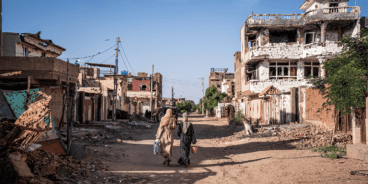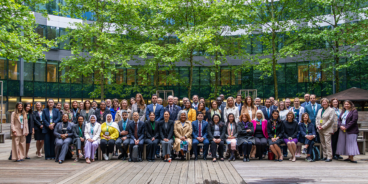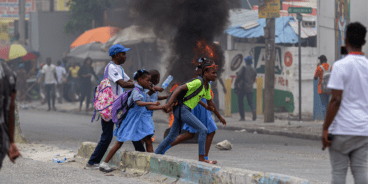
R2P’s next decade
Speech Delivered by Dr. Simon Adams, Executive Director of the Global Centre for the Responsibility to Protect, at “R2P at 10: Progress, Challenges & Opportunities in the Asia-Pacific,” in Phnom Penh, Cambodia, on 27 February 2015.
It is an honor to be here in Cambodia. I was especially moved by the intervention this morning by our colleague from the Cambodian parliament – herself a child survivor of the Khmer Rouge’s crimes against humanity, a former refugee, and now a parliamentarian dedicated to advancing mass atrocity prevention and the Responsibility to Protect (R2P) in this country and across Southeast Asia.
I have been given the unenviable task of setting an agenda for R2P’s next decade in just nine minutes. As such, I am reminded of the words of the Danish physicist Niels Bohr, an avowed anti-Nazi who also won the Nobel Prize for his work on quantum mechanics, who once quipped that: “prediction is very difficult, especially if its about the future.”
While we can’t determine the precise manner in which global politics, international law and R2P will continue to evolve over the next decade, what we know – from the Holocaust and the killing fields of Cambodia to more recent conflicts and crises – is that mass atrocities are a human evil that are not going away.
The civil war in Syria is almost four years old. Iraq has already become an extension of its battlefield and the Syrian conflict’s sectarian poison is seeping across other borders. Large parts of north-eastern Nigeria, covering territory the size of Belgium and home to millions of people, are now ungovernable as Boko Haram continues to commit atrocities and wreak havoc. We can add to this depressing list of situations that dramatically worsened last year, the deadly conflicts in Central African Republic, Sudan, South Sudan, and Libya.
But in the ten years since R2P was adopted at the 2005 UN World Summit, we have also strengthened our understanding of the methods and measures that weaken and undermine the politics of the machete, the mass grave and the death squad. And as we chart a way ahead for R2P over the next decade, let us remind ourselves that we are experiencing a period of increased instability in the international system.
The United Nations Security Council, at the apex of a creaking and weary UN system, is a twentieth century organisation trying to solve twenty-first century problems. For example, the Council’s response to the crisis in the Central African Republic was tardy, in part, because of many wasted weeks where some members of the Council argued that the former colony was France’s problem, despite the fact that the country has been independent since August 1960.
Syria exposed a more fundamental debility in the UN system, namely the historic anachronism of five permanent members who can veto any attempt by the international community to stop mass atrocity crimes if doing so does not accord with their partisan interests. We need deep reform of the UN Security Council over the next decade. And we need a “statement of principles” on veto restraint in mass atrocity situations in time for the seventieth anniversary of the UN later this year.
These are symptoms of the UN’s structural malaise when it comes to preventing mass atrocities. But ten years since the adoption of R2P, what is the overall health of the norm?
We have won the battle of ideas. We now have near universal acceptance of the abstract concept that all states have a responsibility to protect their populations from genocide, war crimes, ethnic cleansing and crimes against humanity. And contrary to what some people would have us believe, there are no longer any clearly defined battle lines between the global “north” and “south,” or the “developed” and “developing” world, on R2P.
We still have to guard against the misuse and abuse of the norm. We are not immune to failure. But the only real debate at the UN these days is about how individual states and the international community should uphold their responsibility to protect in specific cases. The discussion now is about implementation of the most appropriate measures and means, not whether a responsibility exists. This is an enormous and historic change from just ten years ago.
MASS ATROCITY PREVENTION
At the core of R2P is a responsibility to engage. Where states invest in institutional preparedness, we succeed more often than we fail. For example, in 2008 in Kenya a disputed election resulted in ethnic violence that killed 1,133 people and displaced over 663,000. During elections in 2013, however, there was no such widespread and deadly disorder. In between were five years of local, national, regional and international investment in both structural and proximate prevention. These preventive measures covered everything from constitutional change to security sector reform and local peacebuilding initiatives. The lessons from Kenya are too many to be elucidated here, but their relevance certainly extends beyond East Africa.
We are also beginning to better understand the entangled relationship between poverty, underdevelopment and the risk factors that can lead to mass atrocities. Using the post-2015 Sustainable Development Goals, over the next decade we need to use development tools to help ameliorate conflicts where identity politics, social marginalisation, economic inequality and resource disputes threaten fragile societies.
Since 2005 we have also seen the steady development of networks and structures for mass atrocity prevention. For example, the UN’s Human Rights Council (HRC), with its Special Procedures and Universal Periodic Review process, can help us gauge how states are strengthening human rights domestically, and what this means in terms of their institutional resilience to the threat of mass atrocities.
The HRC will always be more of a smoke detector than a fire extinguisher when it comes to mass atrocities, but it is now an indispensable part of our global early warning system, as is the UN Office of the Special Advisors for the Prevention of Genocide and the Responsibility to Protect.
From the United States’ Atrocity Prevention Board to the National Peace Council of Ghana, states are also getting better at consolidating domestic structures. In addition, across regions and continents we have seen the development of state-led communities of commitment, most notably the Global Network of R2P Focal Points, which now encompasses 43 diverse states from the Democratic Republic of the Congo and Côte d’Ivoire, to Guatemala, Australia, the Netherlands and Republic of Korea, to name just a few.
An R2P Focal Point is a senior government representative commissioned to strengthen domestic commitment to atrocity prevention. The Global Network of R2P Focal Points has had high-level endorsement from the UN Secretary-General and should be supported by any government that is serious about prevention.
In this context, I was especially glad to hear Prime Minister Hun Sen pledge yesterday that he will soon appoint an R2P Focal Point, and that he would like to see Cambodia lead on issues related to R2P, including getting more states to ratify the Rome Statute of the International Criminal Court (ICC), in the Southeast Asian region.
PEACEKEEPING AND PROTECTION
Where mass atrocities occur, we need to improve our ability to expeditiously respond. This year is the twentieth anniversary of the Srebrenica genocide where UN peacekeepers shamefully handed over the victims to their executioners.
In an era when eight out of sixteen UN peacekeeping missions have protection of civilians mandates, which involve 90 percent of the 122,000 peacekeepers currently on mission, it is wholly appropriate that the UN is conducting a generational review of peace operations. Other initiatives, like the Secretary-General’s “Human Rights Up Front” plan, also need consolidation across the UN system.
UN Peacekeeping is at the center of civilian protection and conflict stabilization. But the gap between sublime mandates and operational under-resourcing can still swallow up any well-intentioned mission. We need to expand the number of troop contributing countries, decrease the time between the passing of Security Council resolutions and the deployment of forces, improve training and doctrine in mass atrocity response operations, and above all else, ensure that when vulnerable civilians see a blue helmet they are absolutely certain that they will be vigorously protected, not abandoned. The viability and sustainability of regionally-based rapid reaction forces should also continue to be explored.
In the toughest cases, where a state is manifestly unwilling to protect its populations and international military intervention under Chapter VII of the UN Charter is deemed necessary, we need to ensure that protective mandates are not manipulated for opportunistic reasons of “regime change.” That is part of the reason why Brazil’s proposal that there is a “responsibility while protecting” deserved serious diplomatic attention and constructive debate. One of our goals over the next decade should be to ensure that any time the Security Council mandates the use of force, prudential criteria are taken into account. We also need to improve Security Council monitoring and accountability.
However, most future mass atrocity cases that require coercive responses, including military force, will in all likelihood continue to look more like South Sudan or Central African Republic than like the 2011 intervention in Libya. That is to say, they will continue to require complex elements of coercion and consent, with legal authorization of the Security Council and active dialogue about how a state can best uphold its responsibility to protect and how the international community can both assist and compel them to do so. Such cases also demonstrate that R2P’s three pillars have a dynamic and logical (rather than strictly chronological) relationship to one another.
REBUILDING AND BATTLING IMPUNITY
Finally, over the next ten years we need to improve our ability to assist states in rebuilding after conflict. We only need to look to Libya where the failure of the international community to comprehensively engage during the post-2011 rebuilding phase was a contributing factor to the terrorism, lawlessness, corruption and warlordism that have divided the country in half and created two rival governments. Armed groups on all sides are committing war crimes, creating a humanitarian catastrophe and killing their country’s future.
Our other great ten year challenge is the battle against impunity. The ICC is still the most important institutional development in the historic battle against impunity and is, to quote its Chief Prosecutor, the “legal arm of the responsibility to protect.” We need to strengthen the ICC because it has been proven again and again that ending impunity for past crimes is one of the most effective tools for preventing their recurrence. International justice is contagious and accountability in one country can deter potential perpetrators elsewhere.
Related Content


11th Meeting of the Global Network of R2P Focal Points Outcome Document
